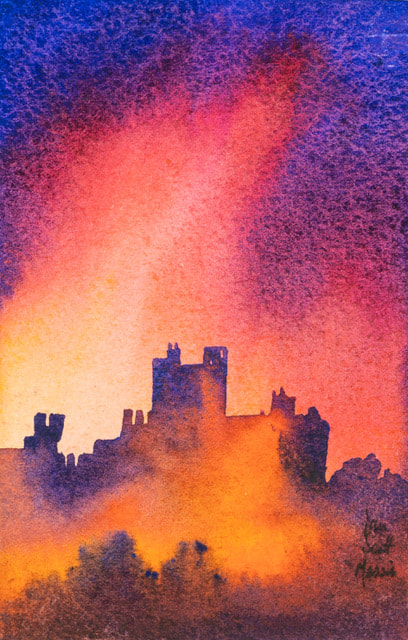Alnwick Castle by Ian Scott Massie
Original Watercolour
10" x 8" Mounted size - 5.5" x 3.5" Image size
Available: unframed @ £165
To shop, please click here
10" x 8" Mounted size - 5.5" x 3.5" Image size
Available: unframed @ £165
To shop, please click here
ALNWICK
Alnwick lies a few miles from the railway, a handsome market town with a medieval castle famed for its gardens. But there’s more to this town than flowers and herbs.
In the 9th century, the Kingdom of Scotland emerged. The long-term residents, the Picts, had united with a tribe from Ireland, known as the Scots, and created a unified nation in the lands north of the Clyde and Forth. England, as a nation, did not exist at this time. Wessex had become the dominant kingdom of the south and Northumbria, which stretched from the Humber to the Forth, of the north. How these kingdoms developed pivots partly on Alnwick.
King Aethelstan united England in 927 and Northumberland was reduced to an earldom, with the Earl of Northumberland having his seat at Alnwick Castle. Less than a hundred years later, Malcom II of Scotland fought for and conquered the land to the North of the River Tweed, splitting the Earldom and beginning England’s struggle to regain its lost territory. As England began to build its forces in the north, Malcolm III made a bid to seize Northern England. But at Alnwick, on November 13th 1093, he and his son were killed in an ambush laid by the Earl of Northumberland. This didn’t end things by a long chalk.
In 1174, William I of Scotland, who had inherited the Earldom, led another bid for power and again it was at Alnwick that events took a decisive turn. He was captured there and imprisoned at Falaise in Normandy. The English army, meanwhile, occupied the five strongest castles in Scotland. William I eventually signed a treaty giving England supremacy over Scotland and was released. So how did Scotland regain independence and why is the border where it is now? The answer, as it is so often in politics, was money. Only 15 years later Richard the Lionheart needed to fund a crusade, so he sold his rights back to the Scots. Not long after, in 1237, the Scottish king gave up his claims to Northumbria and Cumbria and the border was established from the Solway Firth to the mouth of the River Tweed, where it remains to this day.
In the 9th century, the Kingdom of Scotland emerged. The long-term residents, the Picts, had united with a tribe from Ireland, known as the Scots, and created a unified nation in the lands north of the Clyde and Forth. England, as a nation, did not exist at this time. Wessex had become the dominant kingdom of the south and Northumbria, which stretched from the Humber to the Forth, of the north. How these kingdoms developed pivots partly on Alnwick.
King Aethelstan united England in 927 and Northumberland was reduced to an earldom, with the Earl of Northumberland having his seat at Alnwick Castle. Less than a hundred years later, Malcom II of Scotland fought for and conquered the land to the North of the River Tweed, splitting the Earldom and beginning England’s struggle to regain its lost territory. As England began to build its forces in the north, Malcolm III made a bid to seize Northern England. But at Alnwick, on November 13th 1093, he and his son were killed in an ambush laid by the Earl of Northumberland. This didn’t end things by a long chalk.
In 1174, William I of Scotland, who had inherited the Earldom, led another bid for power and again it was at Alnwick that events took a decisive turn. He was captured there and imprisoned at Falaise in Normandy. The English army, meanwhile, occupied the five strongest castles in Scotland. William I eventually signed a treaty giving England supremacy over Scotland and was released. So how did Scotland regain independence and why is the border where it is now? The answer, as it is so often in politics, was money. Only 15 years later Richard the Lionheart needed to fund a crusade, so he sold his rights back to the Scots. Not long after, in 1237, the Scottish king gave up his claims to Northumbria and Cumbria and the border was established from the Solway Firth to the mouth of the River Tweed, where it remains to this day.





